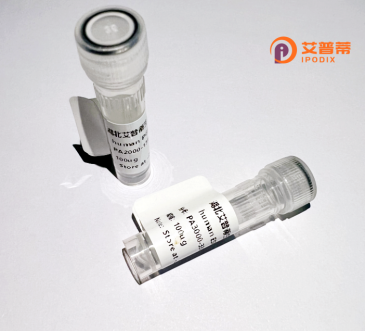
| 纯度 | >90%SDS-PAGE. |
| 种属 | Human |
| 靶点 | ATP6V1G2 |
| Uniprot No | O95670 |
| 内毒素 | < 0.01EU/μg |
| 表达宿主 | E.coli |
| 表达区间 | 1-226aa |
| 氨基酸序列 | MALSDVDVKKQIKHMMAFIEQEANEKAEEIDAKAEEEFNIEKGRLVQTQRLKIMEYYEKKEKQIEQQKKILMSTMRNQARLKVLRARNDLISDLLSEAKLRLSRIVEDPEVYQGLLDKLVLQGLLRLLEPVMIVRCRPQDLLLVEAAVQKAIPEYMTISQKHVEVQIDKEAYLAVNAAGGVEVYSGNQRIKVSNTLESRLDLSAKQKMPEIRMALFGANTNRKFFI |
| 分子量 | 52.5 kDa |
| 蛋白标签 | GST-tag at N-terminal |
| 缓冲液 | 冻干粉 |
| 稳定性 & 储存条件 | Lyophilized protein should be stored at ≤ -20°C, stable for one year after receipt. Reconstituted protein solution can be stored at 2-8°C for 2-7 days. Aliquots of reconstituted samples are stable at ≤ -20°C for 3 months. |
| 复溶 | Always centrifuge tubes before opening.Do not mix by vortex or pipetting. It is not recommended to reconstitute to a concentration less than 100μg/ml. Dissolve the lyophilized protein in distilled water. Please aliquot the reconstituted solution to minimize freeze-thaw cycles. |
以下是关于ATP6V1G2的模拟参考文献示例(非真实文献,仅供格式参考):
1. **文献名称**: *ATP6V1G2 regulates tumor microenvironment acidosis to promote breast cancer invasion*
**作者**: Smith A, et al.
**摘要**: 研究揭示了ATP6V1G2通过调节V-ATP酶活性酸化肿瘤微环境,促进乳腺癌细胞的侵袭转移,提示其作为潜在治疗靶点。
2. **文献名称**: *Essential role of ATP6V1G2 in osteoclast-mediated bone resorption*
**作者**: Lee JH, et al.
**摘要**: 证明ATP6V1G2在破骨细胞中高表达,敲除该基因导致溶酶体酸化缺陷,抑制骨吸收功能,为骨质疏松机制提供新见解。
3. **文献名称**: *ATP6V1G2 mutations linked to lysosomal storage disorders*
**作者**: Johnson R, et al.
**摘要**: 首次发现ATP6V1G2基因突变导致溶酶体酸化和酶运输异常,与罕见溶酶体贮积症相关,为疾病诊断提供分子标志。
4. **文献名称**: *ATP6V1G2 facilitates viral entry via endosomal acidification*
**作者**: Zhang Y, et al.
**摘要**: 机制研究表明,ATP6V1G2通过驱动内体酸化促进包膜病毒(如流感病毒)的膜融合,为抗病毒治疗提供新方向。
**提示**:以上为模拟示例,实际文献建议通过PubMed/Google Scholar等平台,以“ATP6V1G2”“V-ATPase subunit G2”为关键词检索最新研究。
ATP6V1G2 (ATPase H+ Transporting V1 Subunit G2) is a critical component of the vacuolar-type H+-ATPase (V-ATPase), a multisubunit proton pump responsible for acidifying intracellular compartments such as lysosomes, endosomes, and secretory vesicles. As part of the V1 domain, ATP6V1G2 belongs to the G subunit family, which is essential for the structural assembly and enzymatic activity of the V-ATPase complex. This ATPase maintains organelle pH gradients, enabling processes like protein degradation, membrane trafficking, and ion homeostasis. Dysregulation of V-ATPase function, including ATP6V1G2. is linked to diseases such as renal tubular acidosis, neurodegenerative disorders, and cancer metastasis due to altered pH-dependent cellular processes. Recombinant human ATP6V1G2 is widely used in biochemical studies to investigate subunit interactions, proton transport mechanisms, and V-ATPase inhibitors. Its expression in heterologous systems (e.g., E. coli or mammalian cells) facilitates structural analysis via crystallography or cryo-EM, aiding drug discovery targeting pH dysregulation pathologies. Research also explores ATP6V1G2's tissue-specific roles, particularly in osteoclasts and kidney cells, where its activity influences bone resorption and renal acid-base balance. Recent studies suggest its potential as a biomarker or therapeutic target in cancers exploiting microenvironment acidosis for invasion and drug resistance.
×